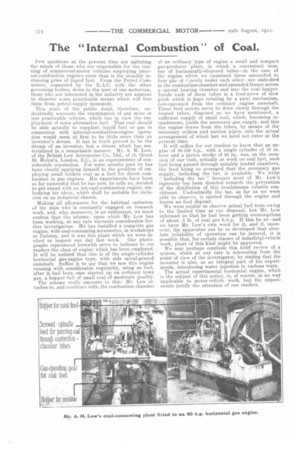The "Internal Combustion" of Coal.
Page 4

If you've noticed an error in this article please click here to report it so we can fix it.
Few. questions at the present time are agitating the minds of those who are responsible for the running of commercial-motor vehicles employing internal-combustion, engines more than is the steadily increasing price of liquid fuel. From the Petrol (2ommittee,. organized by the ILA.C. with the other governing bodies, down to the user of one motorvan, those who are interested in the industry are anxious to discover some practicable means which will free them from petrol-supply monopoly.
This state of the public mind, therefore, undoubtedly warrants the examination of any more or less practicable scheme, which has in view the employment of some alternative fuel. That coal should be able actually to supplant liquid fuel or gas in connection with internal-combustion-engine operation would seem at first to be little more than an inventor's dream. It has in truth proved to be the dream of an inventor, but a dream which has materialized in a remarkable manner. Mr. A. M. Low, of the British Low Accessories Co., Ltd., of 15, Great St. Helen's, London, E.C., is an experimenter of considerable reputation. For some months past he has been closely applying himself to the problem of employing small broken coal as a fuel for direct combustion in gas engines. His experiments have been so far successful that he has now, he tells us, .decided to get ahead with an internal-combustion engine, embodying his ideas, which shall be suitable for inclusion on an industrial chassis.
Making all allowances for the habitual optimism of the man who is constantly engaged on research work, and, who, moreover, is an enthusiast, we must confess that the scheme, upon which Mr. Low has been working, at any rate warrants considerable further investigation. He has installed a complete gas engine, with coal-consuming accessories, in workshops at Dalston, and it was this plant which we were invited to inspect one day last week. Our photographs reproduced herewith serve to indicate to our readers the class of engine which has been employed. It will be noticed that this is of the single-cylinder horizontal gas-engine type, with side spiral-geared camshaft. Suffice it to say that we saw this engine running with considerable regularity, using as fuel, after it had been once started up on ordinary town gas, a hopper full of small coal of moderate quality. The scheme really amounts to this: Mr. Low attaches to, and combines with, the combustion chamber of an ordinary type of engine a small and compact gas-producer plant, in which a convenient number of horizontally-disposed tubes—in the case of the engine which we examined these amounted to
four pla, rY.,rectly under each other-are embodied in the combustion chamber and extended thence across a special heating chamber and into the coal hopper. Inside each of these tubes is a. feed-screw of slow pitch which is kept rotating by a pawl mechanism, cam-operated from the ordinary engine camshaft. These feed screws serve to draw slowly through the heated tubes, disposed as we have mentioned, a sufficient supply of small coal, which, becoming incandescent, yields the necessary gas supply, and this the engine draws from the tubes, by means of the necessary orifices and suction pipes, into the actual arrangement of which last we need not enter at the present time. It will suffice for our readers to know that an engine of 80-100 h.p., with a single cylinder of 10 in. bore and a piston stroke of 25 in., was, on the occasion of our visit, actually at work on coal fuel, such fuel being passed through suitably heated chambers, the feed being so arranged that the necessary gas supply, including the tar, is available. We write "including the tar" because most of Mr. Low's ingenuity, has been directed towards the prevention of the distillation of this troublesome volatile constituent. Undoubtedly the tar, as far as we were able to observe, is carried through the engine and leaves no foul deposit.
We were unable to observe actual fuel tests owing to the limited time at our disposal, but Mr. Low informed us that he had been getting consumptions of about .5 lb. of coal per b.h.p. If this be so—and we have Mr. Low's own word for it, and if, moreover, the apparatus can be so developed that absolute reliability of operation can be insured, it is possible that, for certain classes of industrial-vehicle work, plant of this kind might be approved. We may perhaps conclude this brief review of a system, which at any rate is interesting from the point of view of the investigator, by stating that the inventor is also, as an integral part of his experiments, introducing water injection in various ways. The actual experimental horizontal engine, which is the subject of this notice, is, of course, in no way applicable to motor-vehicle work, but the experiments justify the attention of our readers.






















